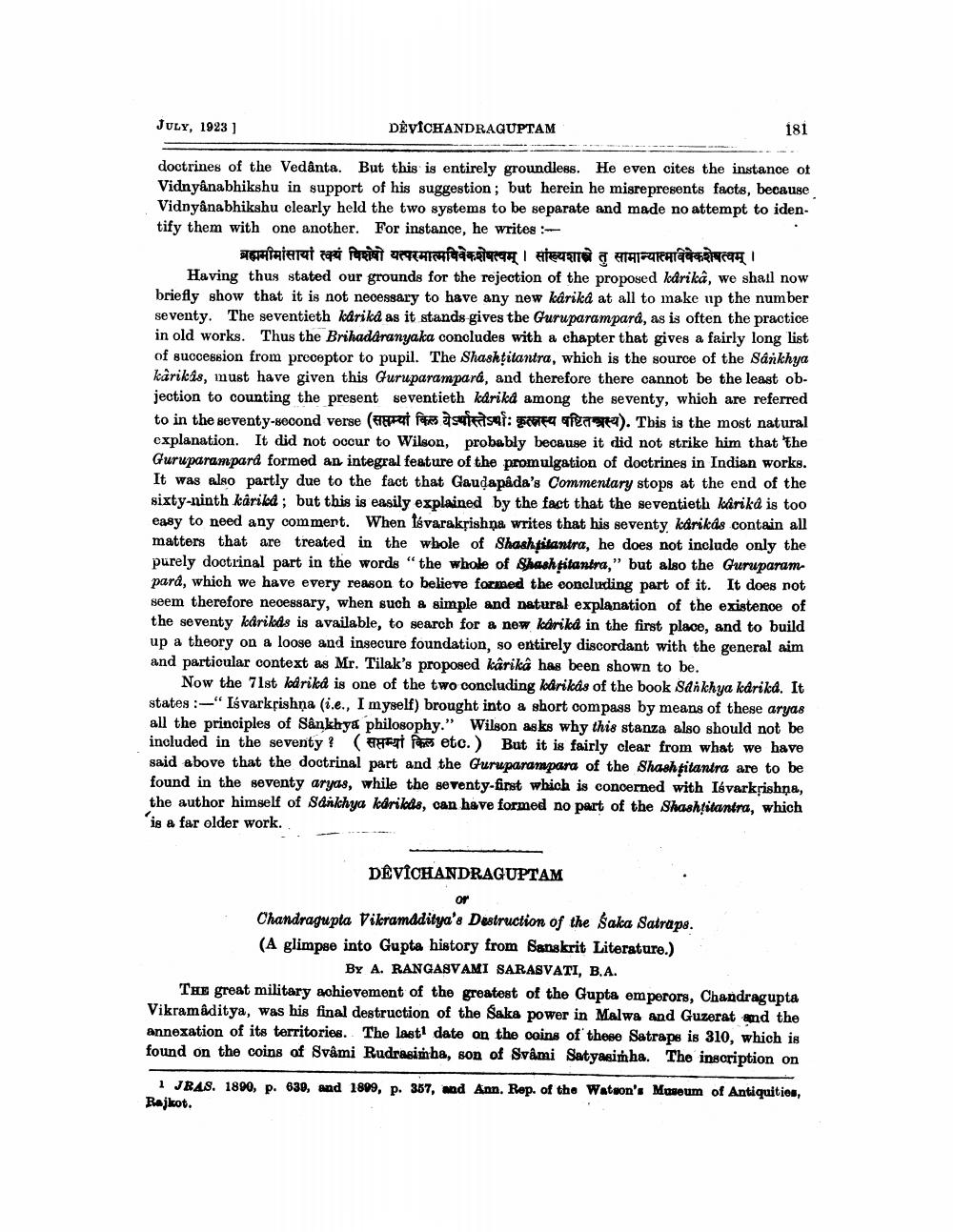________________
JULY, 1923)
DÊYICHANDRAGUPTAM
181
doctrines of the Vedanta. But this is entirely groundless. He even cites the instance of Vidnyánabhikshu in support of his suggestion ; but herein he misrepresents facts, because Vidnyánabhikshu clearly held the two systems to be separate and made no attempt to identify them with one another. For instance, he writes -
ब्रह्मामीमांसायां त्वयं विशेषो यत्परमात्मविवेकशेषत्वम् । सांख्यशाने तु सामान्यात्माविवेकशेषत्वम् । Having thus stated our grounds for the rejection of the proposed karika, we shall now briefly show that it is not necessary to have any new karikå at all to make up the number seventy. The seventieth karika as it stands gives the Guruparampard, as is often the practice in old works. Thus the Brihadaranyaka concludes with a chapter that gives a fairly long list of succession from preceptor to pupil. The Shaskţitantra, which is the source of the Sankhya karikas, must have given this Guruparampará, and therefore there cannot be the least objection to counting the present seventieth kdrikd among the seventy, which are referred to in the seventy-second verse ( ret for Suitat: Echte feast). This is the most natural explanation. It did not occur to Wilson, probably because it did not strike him that "the Guruparampard formed an integral feature of the promulgation of doctrines in Indian works. It was also partly due to the fact that Gaudapáda's Commentary stops at the end of the sixty-ninth karikd; but this is easily explained by the fact that the seventieth karika is too easy to need any comment. When Távarakrishna writes that his seventy karikás contain all matters that are treated in the whole of Shashtitantra, he does not include only the purely doctrinal part in the words "the whole of Shashtitantra," but also the Guruparampara, which we have every reason to believe formed the concluding part of it. It does not seem therefore necessary, when such a simple and natural explanation of the existence of the seventy kárikds is available, to search for a new karika in the first place, and to build up a theory on a loose and insecure foundation, so entirely discordant with the general aim and particular context as Mr. Tilak's proposed kârikâ has been shown to be.
Now the 71st kårikå is one of the two concluding kårikâs of the book Sankhya karika. It states : -" Iśvarkrishna (i.e., I myself) brought into a short compass by means of these aryas all the principles of Sankhya philosophy." Wilson asks why this stanza also should not be included in the seventy? (Heat Pants etc.) But it is fairly clear from what we have said above that the doctrinal part and the Guruparampara of the Shash titantra are to be found in the seventy aryas, while the seventy-first which is concerned with Isvarkrishna, the author himself of Sankhya karikás, can have formed no part of the Shashțitantra, which is a far older work.
DEVICHANDRAGUPTAM
Chandragupta Vikramdditya's Destruction of the Saka Satraps. (A glimpse into Gupta history from Sanskrit Literature.)
By A. RANGASVAMI SARASVATI, B.A. The great military achievement of the greatest of the Gupta emperors, Chandragupta Vikramaditya, was his final destruction of the Saka power in Malwa and Guzerat and the annexation of its territories. The last date on the ooins of these Satraps is 310, which is found on the coins of Svami Rudrasimha, son of Svami Satyasinha. The inscription on
1 JRAS. 1890, p. 630, and 1899, p. 357, med Ann. Rep. of the Watson's Museum of Antiquities, Rajkot.




